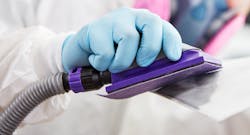What is feather, prime, and block?
Content brought to you by Auto Body Repair Network. To subscribe, click here.
So, what is this process called feather, prime and block? It seems that it is always a point of contention between third-party payers and the repair facility, with the biggest discussion surrounding the need and who should be doing it. I hope that throughout this article I can offer some clarification by providing facts and eliminating opinions.
I found a Collision Industry Conference (CIC) statement that says: The repair process associated with damaged painted body panels typically involves multiple operations: body repair, feather, prime, block, and refinish. The body repair process includes metal finishing and/or the use of body fillers to return the body panel to its undamaged contour. The repaired area is finished to 150-grit and is free of surface imperfections. Feather, prime and block are not-included refinish operations that complete the process from 150 grit to the condition of a new undamaged panel. The refinish process starts at the condition of a new undamaged panel and is outlined and documented in printed and/or electronic time guides. The body/paint labor and materials necessary to prepare the repaired area from 150-grit to the condition of a new undamaged part is a valid and required step in the process. The labor and material allowance for these operations requires an on-the-spot evaluation of the specific vehicle and damage.
Unfortunately, as I read through the refinish operations in the Audatex, CCC/Motor and Mitchell P-pages, I began to see where the disagreement lies, as they do not 100-percent align with CIC.
Audatex
In the Audatex Database Reference Manual, it states that, “Audatex recognizes that Feather/Prime/Block are required operations when replacing welded-on panels. Time to perform this operation is included in the Audatex time for welded panel replacement in the seamed areas to bring the panels to the condition of a new, undamaged panel for the purpose of refinish. Although the time is included, Audatex does not provide a material allowance for the Feather/Prime/Block process. If necessary, the determination and assessment for materials is best provided by the estimate preparer for consideration and allowance during the estimate preparation process.” It goes on to state that “Feather, Prime & Block are required operations in the panel repair process. Audatex Estimating does not provide a labor time allowance for repaired panels, as the amount of time is subjective.”
CCC
As I reviewed the CCC/MOTOR guide to estimating, I found they identify the process as Prime & Block. In their Refinish Time Premise, they offer the following statement: “Prime & block (high build/primer-filler) is a required procedure that restores a repaired panel surface, including the joined areas of replaced welded panels, from 150-grit finish to NEW UNDAMAGED condition. It is MOTOR’s position that prime and block is a refinishing process best reserved for the judgment of an estimator/appraiser following a thorough on-the-spot evaluation of the specific vehicle and damage in question.” The statement doesn’t specify whether it is included or not, as it is not identified in any repair process as an included operation.
Mitchell
Mitchell has the following statement in their collision estimating guide: “Feather, Prime & Block is the not-included refinish operation that completes bodywork repair from 150-grit smoothness to the condition of a new undamaged panel, and the point at which refinish labor time begins. The labor and materials associated with feather, prime and block may vary depending upon the size of the repair area and should be evaluated when determining the work to be performed.
While Mitchell’s statement closely aligns with the CIC determination, none of them offer a time allowance for the process. They all indicate it should be evaluated and determined by the work being performed, and Audatex adds that it is subjective. In an attempt to find some clarity, I reviewed the 3M SOP for Feather, Prime and Block and found it was a process with multiple steps, as CIC suggests.
SOPs for the process
The 3M SOP has the following steps:
- Featheredge the surrounding area using a P180 abrasive on a DA sander.
- Final sand the surrounding area using a P320 abrasive disc on a DA sander. Blow off with clean, dry compressed air. Clean with wax and grease remover. Inspect the repair for quality.
- Mask the repair area as necessary. Refer to our Primer Masking SOP for specific 3M masking recommendations.
- Apply primer to the repair area following manufacturers’ recommendations. Allow the primer to cure.
- Apply 3M Dry Guide Coat over cured primer.
- Hand-sand or “check block” sand the repair area using a P320 abrasive sheet on an appropriately sized hand block. Look for imperfections in the repair area highlighted by the dry guide coat. If necessary, re-apply dry guide coat and continue block sanding to repair any defects as required.
- Reapply 3M Dry Guide Coat over the entire repair area.
- DA sand the repair area using a P400 disc and a soft interface pad until all 3M Dry Guide Coat is removed.
Feather, prime, and block is a refinish process, information providers agree
Through this research, I learned that CCC/MOTOR and Mitchell agree that feather, prime and block is in fact a refinish process. Reviewing the steps identified in the 3M SOP makes it difficult to understand how it could be included in any repair procedure. However, the amount of time required to perform the process is still not identified. During my damage appraisal documentation workshops, I encourage the attendees to determine the time by using a percentage of the panel repair time. I suggest they model their calculation similar to De-Nib & Polish calculations as shown in the CCC/MOTOR P-pages. If there were 3.5 hours of repair time on a panel, you would multiply 3.5 by the percentage you selected to reach the feather, prime & block refinish labor time. Also, by using the formula above for each repaired panel you can develop consistency in your process that will help you gain reimbursement.
Document and educate
As I circle back to my opening paragraph, I hope I have offered some clarification to the feather, prime & block process, why it is needed, and who should be performing the steps. Since the refinish time premise defined in the three estimating databases mentioned is based on one color applied to a new undamaged panel, it is a required refinish operation to restore a repaired panel to that new undamaged condition. With the clarification provided in this article, I feel comfortable that the information will help you overcome any contention with third party payers. The key is in the documentation and educating those opposed to the need for this required process.




